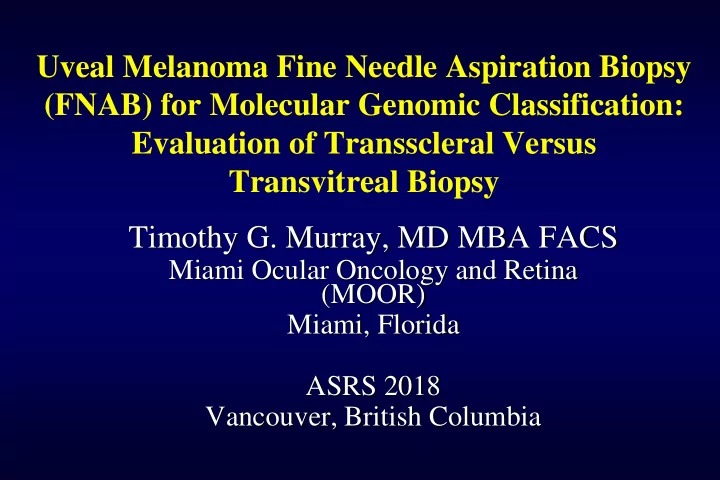

Uveal Melanoma Fine Needle Aspiration Biopsy (FNAB) for Molecular Genomic Classification: Evaluation of Transscleral Versus Transvitreal Biopsy Timothy G. Murray, MD MBA FACS Miami Ocular Oncology and Retina (MOOR) Miami, Florida ASRS 2018 Vancouver, British Columbia
Disclosures • No Relevant Disclosures • Consultant for Alcon Surgical • IST Funding Regeneron
Uveal Malignant Melanoma Management • Globe Conservation – Standard of care utilizing either radiotherapy for Medium/Large Melanoma or Directed Surgical Ablation for Small Melanoma • Radiation retinopathy – Virtually 100% of all macular/juxtapapillary tumors • Molecular Genomics – Chromosomal analysis, GEP RNA screening, biopsy sampling, practical implications
DecisionDx-UM • Castle Biosciences – Validated, CLIA approved • RT-PCR 15 Genes (3 control genes) • CDH1,ECM1, EIF1B,FXR1,HTR2B,ID2,LMCD1,LTA4H MTUS1,RAB31,ROBO1, and SATB1 • Learning algorithm (SVM) • Predicted classification AND discriminant value
DecisionDx-UM • Validation Studies • Worley et al, Clinical Cancer Research, 13(5): 1466-1471, 2007 Comparison Gene Expression Profiling to Monosomy 3 67 patients Monosomy 3 FISH/aCGH, SNP-LOH ONLY Gene expression profile (P<.0001) and tumor size (P<.02) were independent contributors to prognosis
Molecular Signature Class Metastasis Free Class 3 year 5 year Class 1A 98% 98% Class 1B 93% 79% Class 2 50% 28% Censored data 6/9/2011 514 patients p<.0001
FNAB Molecular Genomics Study Purpose • To evaluate the impact and outcomes for two different biopsy approaches for molecular diagnostic testing of uveal melanoma: Trans-scleral versus Trans- vitreal
Study Methods • Institutional review board approved, single surgeon, retrospective review of a prospective, consecutive case series of 353 eyes of 353 patients with posterior uveal melanoma. • All eyes biopsied either at the time of primary brachytherapy or during primary/secondary MIVS melanoma treatment. • All FNAB specimens were processed for uveal melanoma diagnostic testing using a standard processing approach and all testing was completed with a single laboratory (Castle Biosciences, Inc.).
Patient Data • 353 patients (353 eyes) • Age (mean): 69 years (17 to 89 years) • Sex: 187 women/166 men (53% women) • Mean follow-up: 46 months (20 to 74 months)
Trans- Scleral Biopsy Technique • 25 gauge needle • Oblique insertion • Multiple Pass • High aspiration • Inspect biopsy site and immediate brachytherapy application • Intra-operative echographic evaluation
Trans-Vitreal MIVS Biopsy Technique • 23/25+ gauge MIVS pars plana vitrectomy • Remove hyaloid • Remove vitreo-retinal traction overlying tumor • Direct endo-laser confluent tumor treatment • 25 gauge needle • Multiple needle passes within the tumor • Inspect for bleeding • Intravitreal triamcinolone acetonide
Sample Handling
Uveal Melanoma GEP Study Results • 353 Biopsies/353 Eyes • Mean follow-up: 46 months (20 to 74 months) • Biopsy Approach: • Trans-vitreal: 216 eyes (216/353, 61.2%) • Trans-scleral: 137 eyes (137/353, 38.8%) • GEP Analysis: • Determinant Biopsy 333 eyes (333/353, 94.3%) • Multiple Gene Failure 20 eyes (20/353, 5.6%) • GEP Failure Assessment: • Trans-scleral 2 eye (2/137, 1.7%) • Trans-vitreal 18 eyes (18/216, 7.3%) • GEP Failure - Excessive Fluid 10 eyes (10/20, 50%)
Uveal Melanoma GEP Study Results Complications • Vitreous Hemorrhage 8 eyes (8/353, 2.3%) • Progressive Retinal Detachment 5 eyes (5/353, 1.4%) • Trans-scleral Biopsy 1 eye (1/137, 0.7%) • Trans-vitreal Biopsy 4 eyes (4/216, 1.9%) Potential Issues • Tumor Recurrence 0 eyes (0/353, 0%) • Extra-ocular Extension 0 eyes (0/353, 0%) • Hypotony 0 eyes (0/353, 0%) • Endophthlamitis 0 eyes (0/353, 0%)
Uveal Melanoma GEP Study Results GEP Classification Overall • Class1 251 eyes (251/353, 71.1%) • Subclass 1a 78 eyes (78/251, 31.1%) • Subclass 1b 173 eyes (173/251, 68.9%) • Class 2 82 eyes (82/353, 24.6%)
Conclusions • Fine needle aspiration biopsy performed via a trans-scleral OR trans-vitreal multi-pass approach achieves molecular classification in greater than 95% of all patients undergoing treatment for uveal melanoma independent of tumor size • Complications related to FNAB using these techniques are rare but may be both anatomically and visually compromising • Ultimately, genomic profiling is both feasible and informative allowing tumor risk assessment, targeted patient follow-up and consideration of adjunctive therapy
Potential Limitations • Single institutional study • Single surgeon (TGM) • Sample size (353 patients) • F0llow-up (46 months)
Thank you! • MIAMI OCULAR ONCOLOGYand RETINA (MOOR) • Dr. Victor Villegas • Dr. Aaron Gold • Azeema Latiff • Fiona Ehlies
Genomics Case Series Clinical Pearls • Utility of genomic profiling in my clinical practice • Class 2 patients undergo enhanced metastatic screening • Class 2 patients offered adjunctive systemic therapy • Valproic Acid (DEPAKENE) • Ipilimumab (YERVOY) • Class 1 patients stratified by subclassification • Class 1b followed with standard of care • Class 1a offered reduced screening
Recommend
More recommend